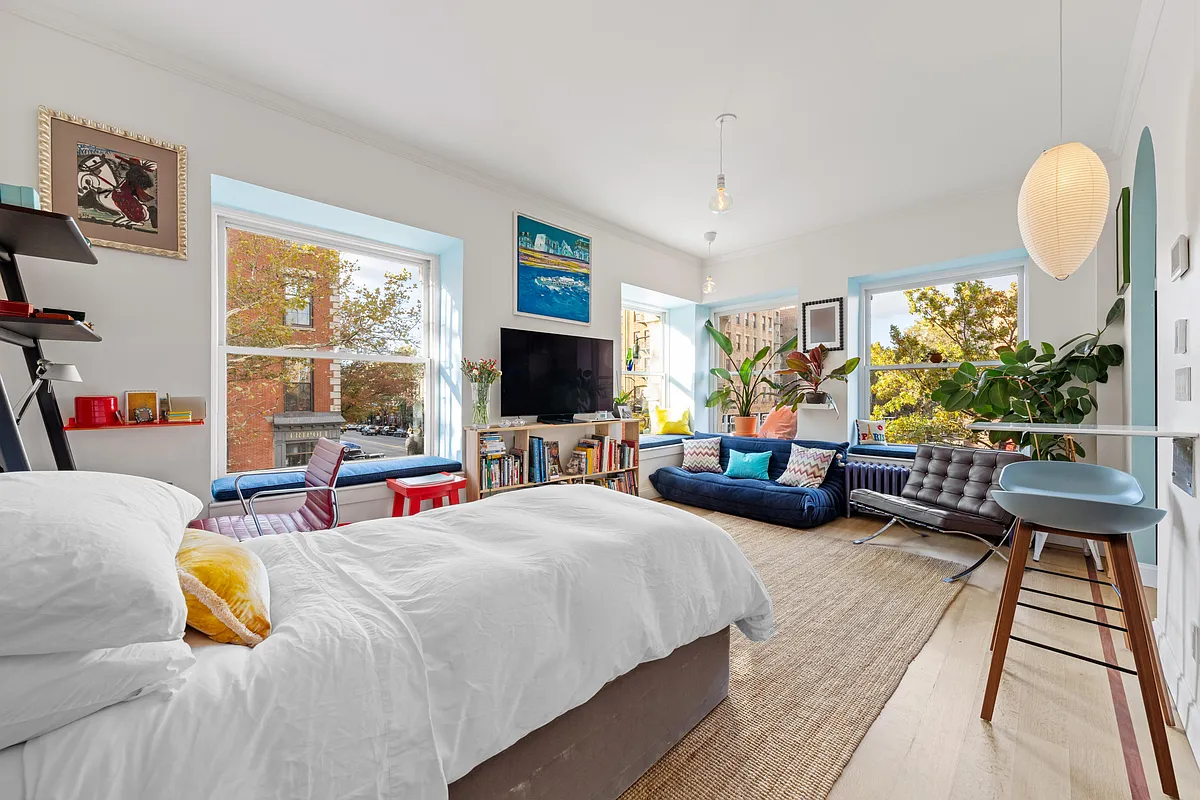News Flash: Everyone Wants to Live in the City
If you weren’t already convinced that city life is becoming increasingly preferable to suburban life, see this article in The New Republic, which looks at a trend called “demographic inversion”—a reversal of the white flight that helped hollow out the inner city beginning in the 1950s. The author quantifies what many Brooklynites already know: the…


If you weren’t already convinced that city life is becoming increasingly preferable to suburban life, see this article in The New Republic, which looks at a trend called “demographic inversion”—a reversal of the white flight that helped hollow out the inner city beginning in the 1950s. The author quantifies what many Brooklynites already know: the neighborhoods closest to vocational and cultural hubs (like, dare we say, Manhattan) and with shopping and services in walking distance are the most popular, forcing poorer folks to move further and further out. There’s been plenty of talk about the suburbs potentially turning into 21st century slums but what will 21st century cities look like if demographic inversion continues? “In the worst case, demographic inversion would result in the poor living out of sight and largely forgotten in some new kind of high-rise projects beyond the city border, with the wealthy huddled in gated enclaves in the center.”
Trading Places [The New Republic]
Beyond Gentrification [Curbed]
Photo by Daily Phototherapy.





parkedslope – “the end of [fill in the blank] era” is so overstated and entirely based on current conditions.
Take energy – we’ve been down this road b/4 – the EXACT same predictions were made in the late 70’s and 80’s – and then we enter 20+ years of cheap and abundant oil.
And while you are right that it could take decades for alternative energy replace oil/fossil fuels – the truth is – it doesnt have to ‘take over’ for us to again enjoy cheap fuel.
China, India etc…. were all using plenty of fossil fuels 10 years ago – and oil was at $11 a barrel. Since then yes – there consumption has greatly increased and BECAUSE oil was $11 a barrel there was insufficient investment in new sources (of oil or alternatives) – now the oppossite is happening – the price of oil has risen above demand – and we are seeing demand destruction (i.e. people driving less, trading in the SUVs).
In order to have “cheap energy” again – we do not need to fully (or even largely) replace oil – all we need is the current factors (renewed investment in oil production, a small % increase in the use of oil alternatives and some demand destruction) to bring the supply/demand equilibrium right back down – while this can’t take place overnight, in a relatively free society – it can happen pretty quickly –
fsrq at 12.28 – I agree that at certain points, for people with certain levels of income and family circumstances, they will still choose to move to the suburbs, but overall, I do not think that will lead to a reversal of the urbanization trend.
As for your second point, regarding white flight, redlining, policing etc., it was a combination of all of the things you and I mentioned. White flight happened first, the redlining of their former neighborhoods followed along with shuttering of businesses that were not being supported or that left because the owners no longer lived in the area, and the police were stretched in their efforts to combat the resultant crime in such impoverished areas. I’m not blaming the police, multiple factors contributed to what happened in those years. Now in many of those areas, you have a mix of working class and some professionals who stuck it out through the bad times, along with new professionals moving in. That in and of itself creates a stronger community base that will hopefully be able to better support the community as a whole.
Hey parkedslope make the bet! I hope you own something or looking to buy.
You know something Asshats there is one thing you can’t stop is DEFLATION!!!!!!!!!!!!
Deflation
http://en.wikipedia.org/wiki/Deflation
During deflation, while consumers can buy more with the same amount of money, they also have less access to money (e.g., as wages, debt, or the return realized on sales of their products). Consumers and producers who are in debt, such as mortgagors, suffer because as their (money) income drops, their (money) payments remain constant. Central bankers worry about deflation, because many of the tools of monetary policy become ineffective as inflation drops below zero (deflation). Deflation may set off a deflationary spiral, where businesses slow or stop investing, because the investment risk is perceived as higher than just letting the money appreciate due to deflation. (The deflationary spiral is the opposite of the hyper-inflationary spiral.) Similarly, in deflation consumers have an incentive to delay consumption, which may contribute to the deflationary spiral.
Print this out and paste it on your fucking face and read it over and over again!
When, not if the Fucktards find out that their “investment” is losing value. They are going to leave everything behind! Yep keep dreaming and to the other assholes BUY SOMETHING, make the bet! Just do it!
The What
Someday this war is gonna end…
Who’s to say that the bubs themselves won’t change? Why only that people will flock to the cities hat ALREADY exist?
Don’t discount technology so fast. What if entire industries move? Why do many industries NEED to be in NY?
I see the urbanization of the burbs as something to chew on.
Parked Slope;
What in the world are you talking about with this statement??
“Just pay a visit to the outer reaches of Brooklyn & you’ll see there are plenty of areas being gentrified – not by ex-Manhattanites, but by Brooklyn natives who are expanding their horizons beyond Bay Ridge, Dyker Beach, etc”
This is total nonsense. If you go to the NYC.gov website, and look at the socioeconomic maps from the 2000 census,you will see that the median income for all of the outer areas of Brooklyn (Canarsie, Flatlands, Sheepshead Bay< Gravesend and Bensonhurst) have declined, as the older stock of population has been replaced by immigrants. These same maps will show you that these areas are now largely populated by immigrant groups.
Please be specific in your claim. Please tell me what areas of outer Brooklyn are being gentrified by “Brooklyn natives”. Please cite some statistics or other sources of material.
Famous Asshole Quotes
“We will not have any more crashes in our time.”
– John Maynard Keynes in 1927
“There will be no interruption of our permanent prosperity.”
– Myron E. Forbes, President, Pierce Arrow Motor Car Co., January 12, 1928
“There may be a recession in stock prices, but not anything in the nature of a crash.”
– Irving Fisher, leading U.S. economist , New York Times, Sept. 5, 1929
“Stock prices have reached what looks like a permanently high plateau. I do not feel there will be soon if ever a 50 or 60 point break from present levels, such as (bears) have predicted. I expect to see the stock market a good deal higher within a few months.”
– Irving Fisher, Ph.D. in economics, Oct. 17, 1929
“… a serious depression seems improbable; [we expect] recovery of business next spring, with further improvement in the fall.”
– HES, November 10, 1929
“Financial storm definitely passed.”
– Bernard Baruch, cablegram to Winston Churchill, November 15, 1929
“… irregular and conflicting movements of business should soon give way to a sustained recovery…”
– HES June 28, 1930
“All safe deposit boxes in banks or financial institutions have been sealed… and may only be opened in the presence of an agent of the I.R.S.”
– President F.D. Roosevelt, 1933
“really can’t happen again (at least not at that scale) – no matter what THE WHAT says.”
-fsrg (Brownstoner full time fucktard) August 8, 2008
The What
Someday this war is gonna end….
The What lives in Lodi, NJ so he’s terrified that what they say might come true.
He’s a real estate broker in the suburbs, who started his rants when the NJ market started to slip, and has since been on a desperate mission to convince everyone on Brownstoner that real estate purchases in the city are bad and moving to the suburbs is good.
It’s all so transparent.
As someone who loves living in cities, I think that this trend is great.
I think, however, that the quality of construction in many suburbs will cause these developments to be replaced with higher-quality construction. A lot of these homes are going to fall apart in 50 years. I do not, however, think that most suburbs are going to become the next slums. We’ve got too much of our housing stock in the US tied up in the ‘burbs. And lets face it, lots of people LIKE the suburbs. What I think will happen is that the suburbs will start taking on more qualities of urban life: walkable commercial nodes, sidewalks, and less auto-focused development.
Or that’s what I hope, at least.
Yes, go ahead, buy in the city…
Fact is, some things have changed since the 60s/70s/80s – no, not everything, just some things.
For starters, the biggest single factor affecting NY’ers is globalization. Its impact can be seen in energy, consumer goods, immigration, race relations, education, financial markets – and of course, real estate.
Simply put, cheap energy, cheap imports & cheap land are all things of the past. The US government no longer has a tight grip on consumer costs because of global competition [and dramatically rising demand] for resources.
While some may cite the 70s as an attempt to claim some cred [nice try, What], it’s much more effective if you take a look at the entire history of NYC & the US as a whole[good for you, 1842].
For almost its entire modern existence, New York city has been dominated by the upper & lower classes. The rise of the middle class here and across America has really been an anomaly fueled by government spending & policies [namely WWII spending on NYC’s ports & shipyards, plus federally-funded urban renewal & rent control/stabilization laws].
Rent control/stabilization is what we often discuss locally, but has anyone here ever heard of the GI Bill? Its no-downpayment/low-rate mortgages [and the bountiful supply of undeveloped rural land close to major cities] essentially created the suburban phenomenon. Which, in-turn, fueled the near-demise of so many American cities over the next 40 years – including NYC.
But just as WWII GI’s are now fading-away, so are the consequences of the GI Bill’s pro-middle class policies. With no more cheap, close-in land to build-on, the suburbs are losing their appeal – not just because of gas prices, but because of difficult commutes, rising taxes & inadequate services[the very things that once made the cities unattractive]. As for the white flight of the 60s/70s, there continues to be a hard-core racist element in our society, but I don’t think they’re a factor any longer in this discussion. People who are so averse to integration will continue to self-select themselves out of the mainstream of the economy.
So what does this mean for you & me?
The suburbs will continue to decline in desirability. Brownstone Brooklyn will weather the current housing crunch fairly well, and new construction will continue to replace the adjacent industrial infill. Middle class families will continue to feel squeezed, but claims that they are being forced out of the city seem to be greatly exaggerated. Just pay a visit to the outer reaches of Brooklyn & you’ll see there are plenty of areas being gentrified – not by ex-Manhattanites, but by Brooklyn natives who are expanding their horizons beyond Bay Ridge, Dyker Beach, etc. For anyone who’s squeamish about leaving a particular ethnic enclave for one that’s mixed, well, too bad for you.
High fuel prices will continue to be the driving force behind all of this: prospects for an outbreak of peace & stability in the Middle East are practically nil. China has finally learned to guzzle gas just like us, and no amount of domestic drilling can satisfy current demand. Since solar/wind/nukes are all still decades-away from bailing us out, don’t expect to see significant long-term drops in energy prices, that is, unless you believe the good people at Exxon-Mobile are eager to give up their streak of record-breaking profits. That’s one thing that will never change!